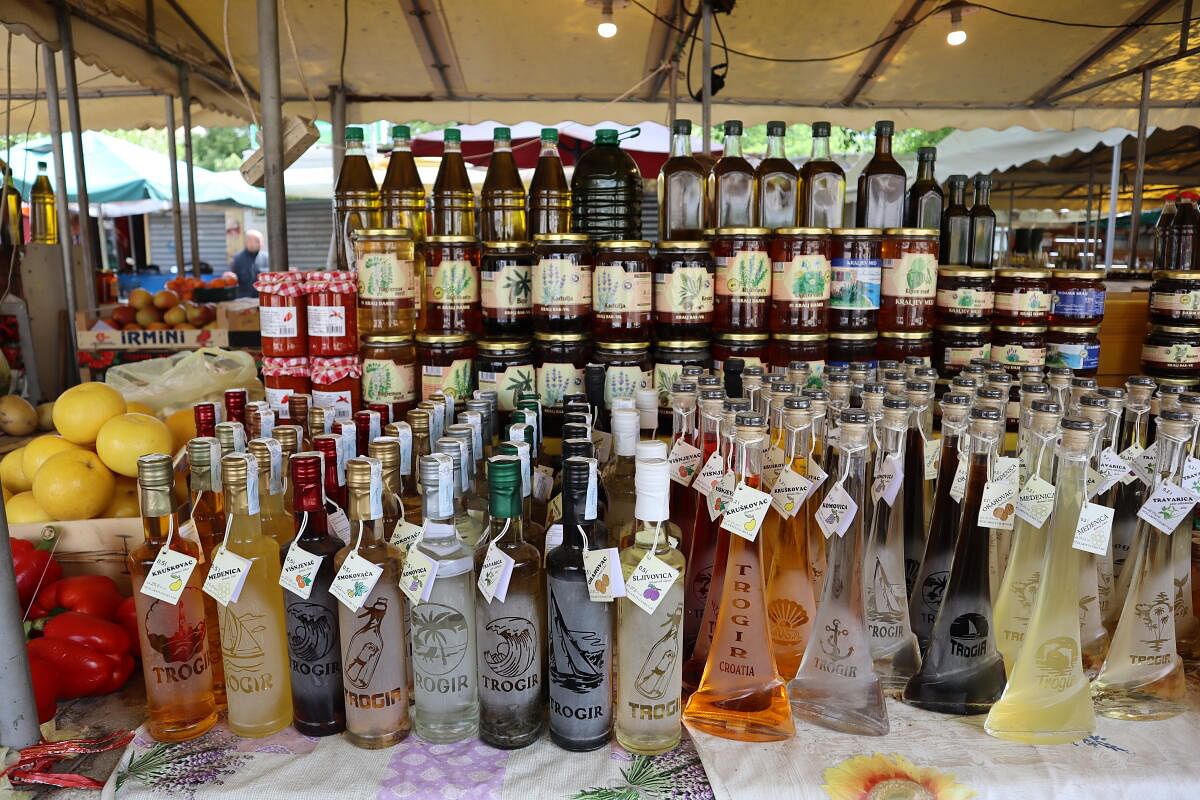
“The recipe is a secret,” says the guide. She points to a wooden barrel upon
which spices and herbs like pepper, ginger, mustard, rose petals, and Angelica root are placed. “These may or may not be in the final recipe.” The secrecy behind protecting this recipe is understandable. After all, the herbal liqueur unicum is made only in Budapest, and only by the Zwack family. They have hidden the recipe for 230 years.
Luckily for me, a tour through the distillery reveals other secrets beyond the recipe. Unicum consists of 40 herbs and spices made by the sixth generation of the Zwack family at a distillery that was bombed thrice during WWII. Production takes six months and involves an ageing process in oak barrels.
Taking a shot at unicum
We visit the cellars containing these weathered barrels, browse through a museum showcasing the history of the drink and the family, and marvel at an impressive collection of miniature liquor bottles from around the world. Unicum is commonly drunk as a shot. The Zwack family produces four million litres of the drink and three million are consumed in Hungary. “We drink it at any time, if in a bad mood or if it is bad weather…anything,” chuckles the guide. “My grandmother drinks it as medicine.”
On the palate, unicum feels medicinal with strong, spicy notes and a potent richness. It is a strong drink but goes down smoothly. I am hooked and promptly pick up two bottles to bring home. Unicum is my first glimpse of just how seriously Europe takes its alcohol, especially its liqueurs. They crowd supermarket shelves and stand proudly at market stalls alongside beer, wine and other liquors. During my 20-day trip to Eastern Europe, I sampled a few of these liqueurs — some as a necessary libation providing warmth from the unseasonal cold and others just to understand the country’s drinking habits.
I first notice unicum at a stall in Budapest’s Central Market Hall. The name sounded interesting, as did the light bulb-shaped bottle. And, standing tall and proud next to it, was another local favourite, pálinka. To learn more about this drink, I visit the Pálinka Museum in the vibrant and happening Jewish Quarter. The museum is lacking, containing just printed information and some token items used in making this spirit. It’s a pity because this beverage is widely considered Hungary’s national drink. There’s even a Hungarian greeting, ‘I wish you a good morning with pálinka’. The first mention of the spirit can be traced back to 1572. Essentially a fruit brandy, pálinka is made from fruit with a good sugar content (plum, apricot, and apple), which gets mashed, fermented, distilled in a pot still, and aged in casks. The Hungarians take their pálinka seriously. There are rules about its consumption. “Pálinka is sipped at room temperature, 2-3 minutes after pouring, and always in a tulip-shaped glass,” says my guide and bartender. I take a sip. “It’s supposed to burn but, that is normal,” she says. It does burn and that’s why it is only consumed in sips and not as a shot. “We drink it when it’s a celebration. My father told me we could have it every day!”
A little warmth goes a long way
The spirit is too strong for me to consume daily. However, in Croatia, I find something that does become a daily libation. On a rainy afternoon at the Zagreb bus station, I seek warmth in a coffee shop. Eschewing the hot beverage options for something stronger, I choose a random liqueur on the menu. Little do I know that this bitter-sweet walnut liqueur, orahovac, would follow me across the country. Orahovac is made with unripe, green walnuts and is spicy on the nose and sweet on the palate with a delicious caramel flavour. My stay in Croatia is marked by gloomy rainy weather and this spirit keeps me warm and my spirits up.
In the coastal town of Split, I find more spirits to help me combat the unseasonal rains. The guide on my food walk, Tonja, helpfully curates a list for me: a white wine called grk made from a grape variety found only on Korčula island; the milder rakia (collective term for fruit brandy) of cherry or honey and finally, Loza. “It’s a digestif,” she says of Loza. “My father would say you can drink it and clean the windows with it.” Giving the window cleaner a wide berth, I source the rakia or cherry brandy liqueur at a stall in the Green Market. Made from Croatian marasca cherries, the drink is stiffer than the orahovac with a fruity scent, and lingering warmth. On the advice of the cashier at a Studenac Market where I go shopping, I pick up honey liqueur (medica/medovaca) and Pelinkovac — medica tastes very medicinal and doesn’t have enough sweetness to balance its potency, while Pelinkovac is extremely bitter.
Drink like a local
The beauty of these liqueurs is that they tell a story. And, it gives me the
chance to meet their makers. In Maribor, Slovenia, I find a fascinating liqueur at a small farmer’s market. At a stall covered with brochures and bottles sporting a purple fruit, I am acquainted with aronija or chokeberry, used to make a delicious dark sweet liqueur.
At a similar, but bigger, farmer’s market just outside St Stephen’s Cathedral in Vienna, I find another liqueur, dirndl. Consumed as an aperitif, Wiener Dirndle is a cherry-coloured organic liqueur made from Cornelian cherry (called dirndl). Although I do consume some wine and cocktails throughout my trip, the liqueurs stand out. After sampling some of these liqueurs, it strikes me that perhaps the secret to a good trip is to drink like a local.